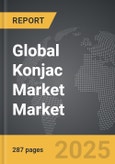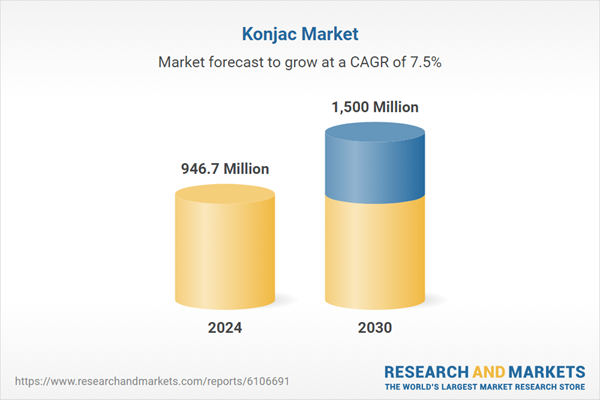Global Konjac Market - Key Trends & Drivers Summarized
Why Is Konjac Becoming a Global Health Food Sensation?
Konjac, a plant native to Asia and known for its high-fiber tuber, is rapidly becoming a staple in global health food markets due to its remarkable nutritional benefits and versatility. At the heart of konjac's appeal is glucomannan, a soluble dietary fiber extracted from the root of the plant, which has been clinically studied for its ability to promote satiety, support digestive health, and aid in weight management. As consumers around the world grow more focused on reducing calorie intake and enhancing gut health, konjac-based products such as noodles, rice, and dietary supplements are gaining popularity. The rise in lifestyle-related health issues like obesity, type 2 diabetes, and metabolic syndrome has driven demand for functional foods that can be easily integrated into daily meals, and konjac fits this need perfectly. It is naturally low in calories, carbohydrate-free, and free of gluten, making it suitable for a wide range of diets including ketogenic, vegan, diabetic-friendly, and gluten-free regimens. Moreover, its ability to mimic the texture of traditional carbohydrates without the associated glycemic impact has helped konjac find a growing audience among weight-conscious and health-driven consumers. Media coverage, influencer endorsements, and the increasing popularity of Asian cuisine have all played a role in bringing konjac into the global spotlight. With expanding applications in both solid and liquid food formats, along with a surge in demand for clean-label, natural ingredients, konjac is transitioning from a regional specialty to a global superfood with wide-ranging market potential.How Are Food and Beverage Companies Leveraging Konjac in Product Innovation?
The food and beverage industry is experiencing a surge of innovation around konjac-based ingredients as companies respond to growing consumer interest in low-calorie, high-fiber alternatives to conventional starches and thickeners. Konjac's functional properties make it highly adaptable across multiple product categories including instant noodles, ready-to-eat meals, jelly snacks, smoothies, and plant-based meat substitutes. Its ability to absorb water and create a gel-like texture allows manufacturers to replicate the mouthfeel of fats and carbohydrates without the corresponding caloric density. This makes konjac particularly attractive for formulating reduced-calorie foods that do not compromise on taste or texture. Beverage brands are incorporating konjac fiber into juices, detox drinks, and meal replacement shakes to enhance satiety and promote digestive wellness. In the realm of confectionery, konjac is being used to create jelly cups and gummies with minimal sugar content, appealing to parents and health-conscious consumers alike. Even the plant-based meat industry is using konjac flour as a binding and texture-enhancing agent, especially in products that seek a clean-label profile without synthetic additives. Manufacturers are also investing in R&D to optimize konjac's flavor-neutrality and improve its stability across different pH and temperature conditions, further expanding its versatility. Packaging innovations and clear front-of-pack labeling are helping to educate consumers about the benefits of konjac, while strategic marketing campaigns highlight its traditional Asian heritage and modern wellness appeal. As demand for multifunctional and health-enhancing ingredients grows, food producers are increasingly turning to konjac as a natural solution that aligns with both regulatory trends and evolving consumer preferences.What Market Trends and Consumer Behaviors Are Shaping Konjac Demand?
The increasing demand for konjac-based products is being strongly influenced by macro consumer trends centered around health consciousness, dietary customization, and plant-based lifestyles. Shoppers are becoming more ingredient-savvy and are actively seeking out foods that offer tangible health benefits such as weight control, blood sugar regulation, and improved digestion. This trend is evident in the popularity of low-carb and low-sugar diets where konjac-based substitutes, especially shirataki noodles and konjac rice, serve as ideal replacements for conventional grains and pasta. Consumer interest in gut health and prebiotic-rich foods has further increased awareness of konjac, as its glucomannan fiber is known to support beneficial gut bacteria and regular bowel movements. The rise in flexitarian and vegan diets has also boosted demand for plant-derived ingredients that offer functionality and clean-label appeal, placing konjac in a favorable position. Social media platforms and health-focused online communities are amplifying the visibility of konjac products through recipe sharing, testimonials, and influencer endorsements. Younger consumers in particular are embracing konjac not only for its health benefits but also for its novelty and alignment with eco-friendly food choices. Retailers and e-commerce platforms are responding by expanding their offerings of konjac products in both branded and private-label formats, often positioning them in health food sections or functional snack aisles. At the same time, awareness campaigns around lifestyle diseases are encouraging consumers to replace refined carbohydrates and processed foods with low-glycemic, high-fiber alternatives. These behavioral shifts, combined with an openness to global flavors and ingredients, are fueling sustained interest in konjac across a broad spectrum of demographics and geographies.What Factors Are Driving Growth in the Global Konjac Market?
The growth in the global konjac market is driven by a combination of health trends, technological innovation, and expanding international trade dynamics. One of the most significant drivers is the increasing recognition of glucomannan, konjac's active dietary fiber, as a functional ingredient backed by scientific research supporting its role in weight management and metabolic health. Regulatory approvals in major markets such as the United States, European Union, Japan, and Australia have opened pathways for konjac inclusion in a wide range of food and supplement applications. Food safety standards and health claims associated with glucomannan have enhanced consumer trust, prompting more companies to incorporate konjac into product development pipelines. Advances in agricultural practices and processing technologies are improving the yield, consistency, and purity of konjac flour and extracts, making supply more stable and scalable. In parallel, rising demand for gluten-free, vegan, and allergen-free products is creating fertile ground for konjac's use in baking, beverage, and snack categories. Export-oriented cultivation in regions like China and Southeast Asia is enabling producers to meet growing international demand while maintaining competitive pricing. Strategic partnerships between konjac suppliers and global food brands are facilitating the development of co-branded products, expanding consumer access in both mature and emerging markets. The increasing role of online grocery platforms and health-focused subscription boxes is also helping introduce konjac products to new audiences. Furthermore, the surge in preventative healthcare and functional nutrition is encouraging individuals to proactively incorporate fiber-rich foods like konjac into their daily routines. These diverse drivers are collectively fueling a robust and expanding global market for konjac, transforming it from a traditional root crop into a highly sought-after ingredient across multiple industries.Report Scope
The report analyzes the Konjac market, presented in terms of market value (US$). The analysis covers the key segments and geographic regions outlined below:- Segments: Product Type (Konjac Gum, Konjac Flour, Konjac Dietary Fiber, Konjac Sponge); End-Use (Food & Beverages End-Use, Pharmaceuticals End-Use, Cosmetics End-Use, Other End-Uses).
- Geographic Regions/Countries: World; United States; Canada; Japan; China; Europe (France; Germany; Italy; United Kingdom; Spain; Russia; and Rest of Europe); Asia-Pacific (Australia; India; South Korea; and Rest of Asia-Pacific); Latin America (Argentina; Brazil; Mexico; and Rest of Latin America); Middle East (Iran; Israel; Saudi Arabia; United Arab Emirates; and Rest of Middle East); and Africa.
Key Insights:
- Market Growth: Understand the significant growth trajectory of the Konjac Gum segment, which is expected to reach US$734.5 Million by 2030 with a CAGR of a 9%. The Konjac Flour segment is also set to grow at 5.1% CAGR over the analysis period.
- Regional Analysis: Gain insights into the U.S. market, valued at $257.9 Million in 2024, and China, forecasted to grow at an impressive 12% CAGR to reach $314.2 Million by 2030. Discover growth trends in other key regions, including Japan, Canada, Germany, and the Asia-Pacific.
Why You Should Buy This Report:
- Detailed Market Analysis: Access a thorough analysis of the Global Konjac Market, covering all major geographic regions and market segments.
- Competitive Insights: Get an overview of the competitive landscape, including the market presence of major players across different geographies.
- Future Trends and Drivers: Understand the key trends and drivers shaping the future of the Global Konjac Market.
- Actionable Insights: Benefit from actionable insights that can help you identify new revenue opportunities and make strategic business decisions.
Key Questions Answered:
- How is the Global Konjac Market expected to evolve by 2030?
- What are the main drivers and restraints affecting the market?
- Which market segments will grow the most over the forecast period?
- How will market shares for different regions and segments change by 2030?
- Who are the leading players in the market, and what are their prospects?
Report Features:
- Comprehensive Market Data: Independent analysis of annual sales and market forecasts in US$ Million from 2024 to 2030.
- In-Depth Regional Analysis: Detailed insights into key markets, including the U.S., China, Japan, Canada, Europe, Asia-Pacific, Latin America, Middle East, and Africa.
- Company Profiles: Coverage of players such as 3M Company, Allegro Industries Inc., ALTA Industries, ASICS Corporation, Bauerfeind AG and more.
- Complimentary Updates: Receive free report updates for one year to keep you informed of the latest market developments.
Some of the 44 companies featured in this Konjac market report include:
- Andi-Johnson Group
- Baoji Konjac Chemical Co. Ltd.
- Best Naturals
- FMC Corporation
- GreenFresh (Fujian) Foodstuff Co., Ltd.
- Hubei Yizhi Konjac Biotechnology Co. Ltd.
- Ishibashiya Konjac Company
- Jellice Co., Ltd.
- Jolion Foods
- Konjac Innov
- KONSON KONJAC
- Matsutani Chemical Industry Co., Ltd.
- Miracle Noodle
- NAH Foods Ltd.
- NOW Foods
- SARDA Bio Polymers PVT. LTD.
- Shanghai Brilliant Gum Co. Ltd.
- Slendier
- The Konjac Sponge Company
- Zeroodle
This edition integrates the latest global trade and economic shifts into comprehensive market analysis. Key updates include:
- Tariff and Trade Impact: Insights into global tariff negotiations across 180+ countries, with analysis of supply chain turbulence, sourcing disruptions, and geographic realignment. Special focus on 2025 as a pivotal year for trade tensions, including updated perspectives on the Trump-era tariffs.
- Adjusted Forecasts and Analytics: Revised global and regional market forecasts through 2030, incorporating tariff effects, economic uncertainty, and structural changes in globalization. Includes historical analysis from 2015 to 2023.
- Strategic Market Dynamics: Evaluation of revised market prospects, regional outlooks, and key economic indicators such as population and urbanization trends.
- Innovation & Technology Trends: Latest developments in product and process innovation, emerging technologies, and key industry drivers shaping the competitive landscape.
- Competitive Intelligence: Updated global market share estimates for 2025, competitive positioning of major players (Strong/Active/Niche/Trivial), and refined focus on leading global brands and core players.
- Expert Insight & Commentary: Strategic analysis from economists, trade experts, and domain specialists to contextualize market shifts and identify emerging opportunities.
Table of Contents
Companies Mentioned (Partial List)
A selection of companies mentioned in this report includes, but is not limited to:
- Andi-Johnson Group
- Baoji Konjac Chemical Co. Ltd.
- Best Naturals
- FMC Corporation
- GreenFresh (Fujian) Foodstuff Co., Ltd.
- Hubei Yizhi Konjac Biotechnology Co. Ltd.
- Ishibashiya Konjac Company
- Jellice Co., Ltd.
- Jolion Foods
- Konjac Innov
- KONSON KONJAC
- Matsutani Chemical Industry Co., Ltd.
- Miracle Noodle
- NAH Foods Ltd.
- NOW Foods
- SARDA Bio Polymers PVT. LTD.
- Shanghai Brilliant Gum Co. Ltd.
- Slendier
- The Konjac Sponge Company
- Zeroodle
Table Information
| Report Attribute | Details |
|---|---|
| No. of Pages | 287 |
| Published | December 2025 |
| Forecast Period | 2024 - 2030 |
| Estimated Market Value ( USD | $ 946.7 Million |
| Forecasted Market Value ( USD | $ 1500 Million |
| Compound Annual Growth Rate | 7.5% |
| Regions Covered | Global |









